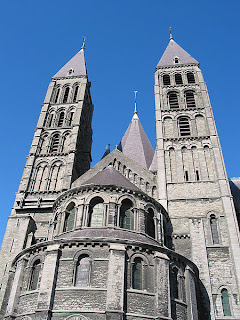Romanesque art and architecture began in the end of the ninth century and lasted through the first half of the eleventh century. No single country came up with the idea of Romanesque art, the process was slow and took place in Italy, France, Germany, and Spain. Gothic art and architecture emerged and dominated western Europe from the middle of the twelfth century to the early fifteenth century. Gothic art began in the Île-de-France. These two arts were very different from each other in both look and in theology; Romanesque architecture focused on keeping God's people safe, and Gothic art was focused on letting God's light in.
Romanesque art styles focused on mosaic, gold work, ivory carving, textiles, and sculpture in wood and stone, (Figure 1). The altar was the most important place in the church and was often decorated with either a sculpture or a painting. These altar decorations were made of ivory, gold, or silver. Gothic art styles, however, preferred to use stone so they could better depict the facial expressions of their sculptures, (Figure 2). Many of these altars depicted scenes of the Judgment day. The architects thought was that, upon entering, the person's view should be focused on the altar. These two altars have the same purpose, but they have entirely different looks and meanings.
Gothic and Romanesque cathedrals had very different looks, both on the outside and on the inside. On the outside, Gothic cathedrals used flying buttresses to support the building, whereas Romanesque cathedrals had used thick walls to support the rib vaulting on the inside. The flying buttresses allowed the walls to become thinner and the ceiling was higher. Romanesque windows were small because the walls had to hold considerable weight. Gothic windows were large and numerous, and stained glass was popular then, (Figure 3). Romanesque buildings had quite a few problems before the building became thick walls made of stone, (Figure 4). Originally, the walls were made of wood, but because the cathedrals used candles as light, many of them burned down. That is why the architects began to use stone. Gothic buildings had some problems too. Not everyone approved of the lavishness of the buildings, and many people were disappointed that the money spent on the buildings was not spent on the poor and sick. Even though there was some controversy and building problems, the buildings were beautiful.
The insides of the cathedrals is where you really see the difference between the art. The Romanesque cathedral is dark and has a very low ceiling, (Figure 5). You can tell how heavy the building was by looking at the inside. The Gothic cathedral, on the other hand, is wide open and bright. The ceiling is high, and the stained glass windows really let the light in. The largest window of the Gothic cathedral is known as the rose window, (Figure 6). The window is said to be the eye to the sky letting God's light shine in. Artists painted wood panels on the insides of the buildings to create illuminations. The interiors of Romanesque churches were covered with plaster and then painted. Many were repainted in layers and layers of beautiful art. The wall paintings that we see today in Romanesque churches were uncovered by painstakingly removing all the layers of paint. The central doorway has the scene of the Last Judgment, and the door-jambs are carved with the Wise and Foolish Virgins, a popular sculpture of the time. The architecture of the different time periods were very different, Romanesque keeping the people safe, and Gothic letting God's light shine in.
Romanesque and Gothic are two architectural revolutions that occurred in most of the world. The altars were used for the same purpose, but they were so very different. The outsides looked similar, but the Gothic was so much more open with large and beautiful windows. The insides had two entirely different purposes. The Romanesque was small and dark, and it was made to be a safe haven for God's people. The Gothic cathedral was open, letting God's light shine in for all to see.
Appendix
 |
| Figure 1. Church of Bredons in Murat. (n.d.). Wikimedia Commons. Retrieved April 27, 2011, from commons.wikimedia.org/wiki/File |
 |
| Figure 2. Gothic Altar from Veit. (n.d.).Wikimedia Commons. Retrieved April 27, 2011, from commons.wikimedia.org/wiki/File |
 |
| Figure 3 Cathedral St. Michael. (n.d.).Wikimedia Commons. Retrieved April 27, 2011, from commons.wikimedia.org/wiki/File:Saints-Michel-et-Gudule_Luc_Viatour.jpg |
 |
| Figure 4 Notre-Dame Cathedral. (n.d.).Wikimedia Commons. Retrieved April 27, 2011, from commons.wikimedia.org/wiki/File |
 |
| Figure 5 Augsburg Cathedral. (n.d.).Wikimedia Commons. Retrieved April 27, 2011, from commons.wikimedia.org/wiki/File:Augsburg-Dom_12.jpg |
 |
| Figure 6 Cathedral Notre-Dame de Reims. (n.d.). Wikimedia Commons. Retrieved April 27, 2011, from commons.wikimedia.org/wiki/File: |